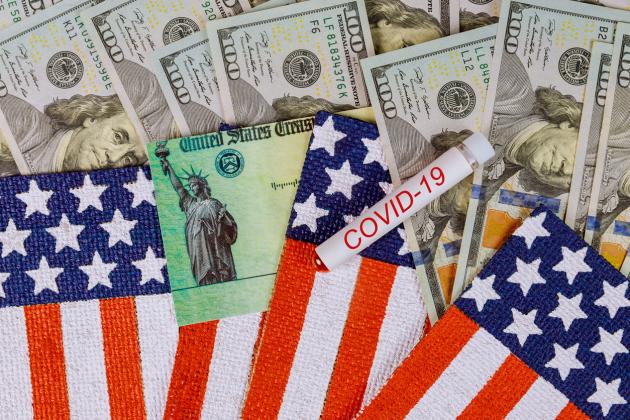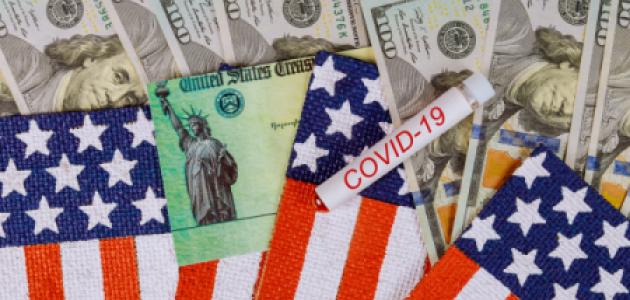In two Defining Ideas articles in 2009, “Who’s Afraid of Budget Deficits? I Am” and “Furman, Summers, and Taxes,” I criticized Lawrence Summers and Jason Furman, two prominent economists who worked in the Obama administration, for their dovish views on federal debt and deficits. They had argued that we shouldn’t worry much about high federal budget deficits and growing federal debt. Of course, that was before the record budget deficit of 2020. Now even Summers is worried. In two February op-eds in the Washington Post, Summers argues against the size and composition of the Biden “stimulus” bill.
Summers makes a solid argument, on Keynesian grounds alone, that the proposed $1.9 trillion spending bill is much too large. He also, to his credit, digs into some of the details of the bill, pointing out how absurd they are. Had Summers looked at more details, he could have made an even stronger case against the measure. For instance, one major provision of the bill, the added unemployment benefits through August, will actually slow the recovery. And other provisions of the bill, like the bailout of state and local governments, are bad on other grounds. The fact is that this is not your father’s or your grandmother’s run-of-the-mill recession. It was brought about by two things: (1) people’s individual reactions to the threat of Covid-19 and (2) politicians’ reactions, in the form of lockdowns, to the same threat.
First, though, let’s consider Summers’s big-picture case. A standard way that Keynesian economists, including Summers, evaluate a spending program to stimulate the economy is to consider the difference between the actual output (gross domestic product) of the economy and the potential output, that is, the GDP that would exist at full employment. They then advocate an increase in federal spending to close this gap. The typical increase they favor is less than the gap because of the so-called multiplier effect, the idea that when the feds spend a dollar the increase in spending in the economy is more than a dollar. Such multipliers, you might or might not be surprised to know, are difficult to estimate in advance, a fact that many Keynesians readily admit. But whatever the multiplier is, we know that if the difference between potential and actual output is $x billion, the stimulus spending, in the Keynesian view, should be less than $x billion.
Now comes the shocker. The stimulus spending in the Biden bill is a multiple of x. Summers quotes an estimate from the Congressional Budget Office that with the $900 billion measure Congress enacted and President Trump signed in December, the gap between actual output and potential output will fall from about $50 billion a month at the beginning of 2021 to only $20 billion a month at the end. He then notes that the Biden measure would spend about $150 billion per month over many months. So the spending is three times the current shortfall and over seven times the expected shortfall in December.
A major problem with the Keynesian model is that in its simplified form, which, amazingly, is still the one that Keynesian economists use to decide on the amount of spending needed, a dollar that the feds spend on item A is the same as a dollar they spend on item B. Summers, disappointingly but not surprisingly, does not challenge that view directly. He regards the $150 billion per month as overly stimulative whatever it is spent on.
However, Summers does grant the basic fact that one dollar spent on one item could be better or worse than one dollar spent on another item. And he finds much that is bad or, at least, inappropriate. In his February 7 op-ed in which he replies to critics and questioners, Summers notes, “Proposed expenditure levels for school support exceed $2,000 per student.” To put that in perspective, per-pupil spending in K–12 schools in academic year 2017, the most recent year for which we have data, was $13,094. So $2,000 is a huge increase in federal spending on something that, in the government sector at least, has been largely the preserve of state and local governments.
Summers also points out in his February 4 op-ed that the ratio of proposed spending to income loss is even greater for low-income families. He writes:
In normal times, a family of four with a pretax income of $1,000 a week would take home about $22,000 over the next six months. Under the Biden proposal, if the breadwinner were laid off, the family’s income over the next six months would likely exceed $30,000 as a result of regular unemployment insurance, the $400-a-week special unemployment insurance benefit, and tax credits.
Disappointingly, though, Summers doesn’t point out that if the purpose of a stimulus program is to stimulate, paying people an extra $400 a week as long they’re unemployed is a bad idea. This omission is all the more striking given that Summers, in the late 1980s and early 1990s, was prominent in arguing that paying people to be unemployed will cause many of the unemployed to stay out of work longer. Indeed, in his article “Unemployment” in my 1993 Fortune Encyclopedia of Economics, later renamed The Concise Encyclopedia of Economics, Summers wrote:
The second way government assistance programs contribute to long-term unemployment is by providing an incentive, and the means, not to work. Each unemployed person has a “reservation wage”—the minimum wage he or she insists on getting before accepting a job. Unemployment insurance and other social assistance programs increase that reservation wage, causing an unemployed person to remain unemployed longer.
Economists since then have done a number of studies of the effect of extending unemployment benefits beyond the traditional twenty-six weeks, and the bottom line is that the effect is large. For example, Rob Valletta and Katherine Kuang, two economists at the San Francisco Federal Reserve Bank, wrote in November 2010:
By easing the financial burden of long-term unemployment, extended benefits reduce the incentives of eligible workers to search for jobs and fill vacancies. Research by Valletta and Kuang (2010) suggests that the impact of extended insurance benefits on the unemployment rate in late 2009 was only about 0.4 percentage point. Updated estimates for all of 2009 and the first half of 2010 suggest a larger impact of about 0.8 percentage point.
More recently, economists Marcus Hagedorn of the University of Oslo, Iourii Manovskii of the University of Pennsylvania, and Kurt Mitman of Stockholm University, in a 2016 study published by the National Bureau of Economic Research (“The Impact of Unemployment Benefit Extensions on Employment: The 2014 Employment Miracle?”), found that 2.1 million people got jobs in 2014 due to the ending of the extended unemployment benefits.
Of course, what we would really like to know is the effect of the double whammy of extending unemployment benefits through August and increasing them by $400 per week. The latter measure would cause millions of unemployed people to make more money by being unemployed than by being employed. My own admittedly intuitive guess is that if the bill passes with those benefits, at least two million workers who would have been working will be out of work. That one provision of the “stimulus” bill, in short, would create a drag on the economy.
The other major absence from Summers’s critique is any mention of the huge bailout for state and local governments. Last June, in “Just Say No to State and Local Bailouts,” I noted the Federation of Tax Administrators’ estimate that the combined effect of the pandemic and the state government lockdowns would be a loss of $152 billion in state government revenues through the end of their fiscal years. I also pointed out that the state governments’ rainy-day funds plus their year-end balances totaled $90 billion. So the needed cuts in spending to stay within the states’ balanced-budget requirements would have been $62 billion, which was only 7 percent of the prior estimated tax revenues.
These numbers, it turns out, were overly pessimistic. The Committee for a Responsible Federal Budget estimates that state and local government tax collections by the end of 2020 were over 2 percent higher than in the fourth quarter of 2019. It should be even easier for Congress to “just say no” to state and local bailouts. Unfortunately, the $1.9 trillion bill contains $350 billion for state and local governments, territories, and tribes.
Why doesn’t Summers mention the state and local government bailout? I don’t know, but here’s a hypothesis. He wants to get Democrats to listen to him but he knows they’ll turn off if he is too critical. Thus Summers softens his criticism of the bill by writing, “Its ambition, its rejection of austerity orthodoxy, and its commitment to reducing economic inequality are all admirable.” Senator Elizabeth Warren, in her book A Fighting Chance, recalled the advice that Summers had given her in a dinner conversation early in her time as a US senator:
Larry’s tone was in the friendly-advice category. He teed it up this way: I had a choice. I could be an insider or I could be an outsider. Outsiders can say whatever they want. But people on the inside don’t listen to them. Insiders, however, get lots of access and a chance to push their ideas. People—powerful people—listen to what they have to say. But insiders also understand one unbreakable rule: They don’t criticize other insiders. (Italics in original.)
I don’t know if this is true, but it fits. Larry Summers has been an insider for a long time and it’s probably hard for him to criticize his allies. That makes his criticism of this bill all the more credible.
I’m an outsider and so it’s easier for me to call them the way I see them. Here are the two major things I see, both of which undercut the case for any stimulus bill.
First, the economy is recovering. In January, the International Monetary Fund predicted that real GDP will grow by 5.1 percent in 2021. Possibly that’s because the IMF understands that this is not a typical recession. The slump we’re in was due initially to people’s fear of the virus, a fear whipped up by Dr. Anthony Fauci and others. But now it’s due mainly to lockdowns. As the percent of the US population that has had COVID-19 rises and the number of people vaccinated rises, we are getting closer to herd immunity. Then people will feel even safer going out and governments will have fewer excuses to keep their economies locked down. We can all become Florida or Florida-Plus. That will all happen without any stimulus bill.
Second, the $1.9 trillion bill represents government taxing us or our children in the future to spend money in places where we the people have chosen not to spend it now. The bill is, in essence, a huge instance of central planning with government officials’ preferences overriding ours. The bill, for example, contains $28 billion for transit agencies, $11 billion in grants to airports and airplane manufacturers, and $2 billion in grants to Amtrak and other transportation. How does the government know that those are the right amounts? What if, as I predict, when the pandemic and lockdowns end we will still have fewer people wanting to ride transit because they and their employers will opt for a hybrid model of some at-home work and some in-office work? The effect of this misallocation of resources won’t necessarily show up in GDP because GDP measures government spending at cost rather than at value. But this spending will make us somewhat worse off. It’s far better to rely on people having the freedom to make their own allocations.
If the government gets out of the way, the economy will recover. Maybe it takes an outsider to see that and to say that. I just did.
















